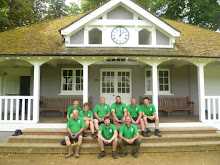 |
| Seedlings |
The seeds are germinating rapidly and the seedlings now need to be pricked out which has lead to a problem of space in which to house them within the large greenhouse.
 |
| No Room, Seedlings and Cuttings |
A few weeks ago the first of the seedlings were pricked out and have occupied the space that was made following the removal of the plants, produced from last September's cuttings, in to the colder, smaller greenhouse. In order to continue this movement of the seedlings and cuttings the plants in the colder greenhouse now have to be moved again, this time in to the cold frames outside.
 |
| Cuttings In The Colder, Smaller Greenhouse |
 |
| Empty Cold Frames | |
The cold frames have been cleaned out and are ready to be filled by the cuttings which will leave a large space where they once stood, but not for long!
 |
| Filled Cold Frames |
Back in the large greenhouse the next section of staging is emptied by the movement of more plants in to the cold greenhouse but by the end of the day this would be filled by the newly pricked out seedlings.
 |
| Pricking Out |
In a few weeks time this process will begin again as the last dozen pots of seedlings will need to be pricked out and there is no space for them to go. The plants that were moved in to the small greenhouse today will be moved out in to the cold frames, the remaining cuttings moved in to the space and the last dozen pots of cuttings pricked out and placed on the empty section of staging. By mid May all the cuttings will have been moved in to the cold frames ready to be planted out at the beginning of June when they will be used to create the container and borders displays this summer.
 |
| The Space Filled |


















 .
.
































